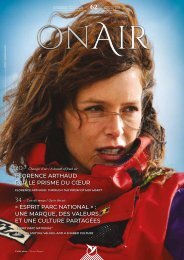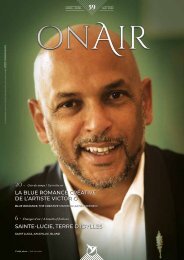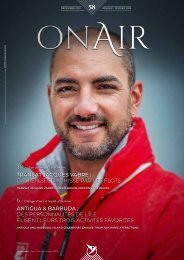TC_04_V16
You also want an ePaper? Increase the reach of your titles
YUMPU automatically turns print PDFs into web optimized ePapers that Google loves.
THE COMPANY / LA COMPAGNIE<br />
of the trade, the procedures, the timelines, the tools to<br />
use… the goal being to master the process.<br />
respecter les règles de l’art, les procédures, les chronologies,<br />
les outils à utiliser, le but étant de maîtriser les process.<br />
That means that the technicians ensure maintaining the<br />
planes, other equipment, and the infrastructure in good<br />
condition, using these tools, as it were. The machines,<br />
or planes, go in for maintenance after a certain<br />
number of flight hours as defined by the manufacturer<br />
and integrated into our maintenance program. The<br />
inspections are more or less important based on the<br />
systems, the goal being to scan the plane in order to<br />
detect eventual defects.<br />
Cela nécessite donc que les techniciens assurent aussi le<br />
maintien en bon état des équipements, du matériel et des<br />
infrastructures. Leurs outils de travail, en quelque sorte. Les<br />
machines, ou avions, entrent en maintenance après avoir<br />
« consommé », un nombre d’heures de vol défini par le<br />
constructeur et repris dans notre programme d’entretien. Les<br />
inspections peuvent être plus ou moins importantes suivant<br />
les systèmes, le but étant de parcourir la machine afin de<br />
détecter les défauts éventuels.<br />
navigability” (Part-CAMO) are kept separate at airlines; in<br />
order to limit bias, the two entities remain independent.<br />
The goal of the Part-145 is to handle the maintenance<br />
of the planes, improve needed equipment, and maintain<br />
compliance with quality processes and the work as<br />
required.<br />
<strong>TC</strong> - What is your background in the industry?<br />
AP - I always preferred businesses on a human scale.<br />
For me, it is always more remarkable and enriching to<br />
participate in the evolution and progression of these<br />
smaller-scale companies. That did not prevent me from<br />
working for such companies as Air France, TAT Industries,<br />
Star Airlines, and Snecma during and after my training.<br />
I entered this profession by the side door. First a CAP<br />
(certificate of professional aptitude, in partnership with<br />
Avialaval, before a BAC Pro at Snecma, which opened<br />
the doors to Air France for my last year of specialized<br />
training.<br />
I followed the most traditional course of study: CAP / BAC<br />
/ Mention and License B1-1. After obtaining the various<br />
diplomas necessary for aeronautical maintenance and<br />
my License B1-1, I got additional experience at Star<br />
Airlines, on the Airbus A320/330, then at TAT Nimes for<br />
maintenance of the CL-415 Canadair (Pelican) as well<br />
as the DC10 and 737.<br />
Next, I was contacted to work at St Barth Commuter,<br />
where I stayed for five years, from 2006 to 2010. I left to<br />
work on business aviation in Switzerland on the Beech<br />
90/100/200/PA-46, etc. After two-and-a-half-years as<br />
hangar manager, I finally returned to the tropical sun<br />
of St Barth Commuter in early 2014, first as a technician,<br />
then hangar manager, and finally maintenance director<br />
in 2018.<br />
<strong>TC</strong> - How do you deal with increased demands from<br />
aeronautical authorities?<br />
AP - Safety is not a meaningless word when it comes to<br />
air transportation. Something hits the wing of a plane, or<br />
there is a small technical problem, and the consequences<br />
could be catastrophic. In order to ensure the maximum<br />
safety of the passengers, we define and optimize the<br />
means for implementation made available to members<br />
of my staff so that they can do their jobs in the best<br />
conditions to maintain or improve their performances. We<br />
follow the recommendations made by the manufacturers<br />
and aeronautical authorities in order to respect the rules<br />
/ navigabilité » (Part-CAMO) sont bien séparées au sein<br />
des compagnies aériennes ; afin de limiter le parti pris, ces<br />
deux entités sont indépendantes. Le Part-145 a donc pour<br />
but d’effectuer la maintenance des avions et d’améliorer les<br />
équipements nécessaires pour sa production afin de maintenir<br />
en conformité les processus qualité et le travail demandé.<br />
<strong>TC</strong> - Quel est votre parcours dans le domaine ?<br />
AP - J’ai toujours privilégié les entreprises à taille humaine. Pour<br />
moi, participer à l’évolution, à la progression de ces structures<br />
« à taille humaine », est plus remarquable et enrichissant. Cela<br />
ne m’a pas empêché de travailler pour des entreprises telles<br />
qu’Air France, TAT Industries, Star Airlines ou Snecma durant et<br />
après ma formation.<br />
Je suis rentré dans ce métier par la petite porte. D’abord, un<br />
CAP, en partenariat avec Avialaval, avant de poursuivre sur un<br />
BAC Pro chez Snecma, qui m’a ouvert les portes d’Air France<br />
pour ma dernière année de Mention Complémentaire.<br />
J’ai donc suivi le cursus le plus standard : CAP / BAC / Mention<br />
et Licence B1-1. Après obtention des différents diplômes<br />
nécessaires en maintenance aéronautique et de ma Licence<br />
B1-1, j’ai forgé mon expérience en passant chez Star Airlines, sur<br />
Airbus A320/330, puis à la TAT Nîmes à l’entretien des CL-415<br />
Canadair (Pélican) et autres DC10 et 737.<br />
Par la suite, j’ai été contacté pour travailler chez St Barth<br />
Commuter, où je suis resté cinq années, de 2006 à 2010. Je<br />
suis ensuite parti travailler en Suisse pour y faire de l’aviation<br />
d’affaire sur Beech 90/100/200/PA-46 ect.. et obtenir un poste<br />
de chef hangar durant deux ans et demi, avant de finalement<br />
revenir sous le soleil de St Barth Commuter début 2014, en tant<br />
que technicien, puis responsable hangar et enfin responsable<br />
maintenance en 2018.<br />
<strong>TC</strong> - Comment faites-vous face aux exigences grandissantes<br />
des autorités aéronautiques ?<br />
AP - La sécurité n’est pas un vain mot dans le transport aérien.<br />
Un impact sur une aile d’avion, un petit problème technique, et<br />
les conséquences peuvent être catastrophiques. Afin d’assurer<br />
une sécurité maximale des passagers, nous définissons et<br />
optimisons les moyens à mettre en œuvre et à disposition des<br />
membres de mon équipe afin qu’ils réalisent leur travail dans<br />
les meilleures conditions pour maintenir ou améliorer leurs<br />
performances. Nous travaillons à partir des recommandations<br />
des constructeurs et des autorités aéronautiques afin de<br />
Each maintenance task is signed and dated by a<br />
technician, making him responsible for that task until<br />
the next time it is done — during that time, the plane will<br />
carry hundreds of passengers.<br />
In addition to this scheduled activity, we also have to<br />
deal with breakdowns and other wear and tear on our<br />
aircraft, which can impact our profitability.<br />
To corroborate all this and evaluate our performance,<br />
PART-CAMO (the client) publishes a monthly and annual<br />
reliability review which includes all the figures (number<br />
of breakdowns/flight hours/maintenance/hours a<br />
plane is immobilized), enabling us to quickly identify<br />
the causes, in order to edit and adjust our man-hour<br />
plan each year to best meet the company’s values and<br />
compliance rules.<br />
<strong>TC</strong> - How do you manage the ever-increasing number<br />
of reservations, which means more flights, the<br />
possibility of more technical problems, and more<br />
needs for maintenance…?<br />
AP - I think that is the most challenging part of our<br />
profession. It is our duty to anticipate changes in<br />
business activity and workloads.<br />
Since I took this job in 2018, the Part-145 has seen a<br />
major transformation, aimed primarily at establishing<br />
maintenance standards worthy of companies in France,<br />
by putting a culture of professionalism in place. At the<br />
same time, we have started a solid program to train<br />
future technicians by opting for alternation, in order<br />
Chaque tâche de maintenance est émargée, signée par un<br />
technicien, le rendant donc responsable de cette tâche jusqu’à<br />
sa prochaine exécution — sur cette période, l’avion emportera<br />
des centaines de passagers. A cette activité programmée<br />
s’ajoute la gestion des éventuelles pannes, l’usure des machines<br />
due à l’exploitation, qui impacte notre rentabilité.<br />
Pour corroborer tout cela et évaluer notre performance, le<br />
PART-CAMO (le client), édite mensuellement et annuellement<br />
une revue de fiabilité qui reprend tous les chiffres (Nb<br />
pannes/H. vols/H. maintenance/temps Immobilisation), ce qui<br />
nous permet d’identifier rapidement les causes, afin d’éditer,<br />
et d’ajuster, chaque année, notre plan Hommes/Heures pour<br />
répondre au mieux aux valeurs de l’entreprise et aux règles<br />
de conformité.<br />
<strong>TC</strong> - Comment gère-t-on une affluence toujours plus<br />
forte : plus de réservations donc plus de vols, davantage<br />
de problèmes techniques et davantage de visites en<br />
maintenance… ?<br />
AP - Je pense que c’est la partie la plus déterminante de notre<br />
métier. Prévoir au mieux l’évolution de l’activité afin d’anticiper<br />
les charges de travail est un devoir.<br />
Depuis mon entrée en fonction en 2018, le Part-145 a entrepris<br />
une profonde transformation, visant principalement à établir<br />
des standards de maintenance, dignes des entreprises<br />
métropolitaines, en cherchant à mettre en place une culture de<br />
professionnalisme. En parallèle, nous avons démarré un travail<br />
de fond pour la formation des futurs techniciens en faisant le<br />
choix de l’alternance, afin de bâtir une équipe capable de<br />
rivaliser avec la concurrence, toujours plus pressante.<br />
34<br />
the commuteR #<strong>04</strong><br />
YOUR LOCAL IN-FLIGHT 35

















